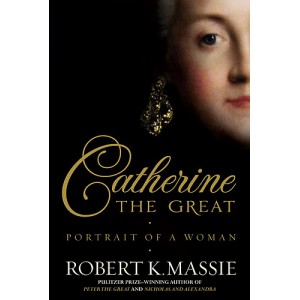"Catherine the Great" by Robert K. Massie

Above: Catherine the Great, Portrait of a Woman. Robert K. Massie, Random House.
The cultural foundations laid by Catherine buttress Russian cultural resiliency today. That is why it is important to understand Catherine the Great.
I completed reading this book today.
I love visiting Russia. In four visits to the country, I've been to St. Petersburg, Moscow, Kiev, five republics in the Caucusus, and Siberia.
I am in awe of the strength of the Russian people.
They have repelled invasion after invasion, and suffered greatly under the tyranny of their own communist leadership.
Russians, having lost millions of people by repelling agression and to the consequences of tyrannical leadership during the communist period, should be a beaten down people... a failed nationality.
What holds them together as a culture? Why are they still there, seemingly having a disproportionately significant impact on the world scene?
Indeed. Russia and Russians continue to suffer. Some might say Russia is a failed culture. Alcoholism is rife. Russia loses 1 million people annually to natural population decline.
Notwithstanding, Russians seem resilient. They hold a strong sense of national identity when nations of the west seem to be losing cultural integrity.
One reason for this resiliency is Russians' strong identity with their amazing cultural heritage. Russia produced Pushkin, Gogol, Dostoevski, Tolsty, Turgenev, Checkov, Bordin, Rimsky-Korsakov, Mussorgski, Tchaikovsky, and Stravinsky.
The above artists and their work are an important part of Catherine The Great's legacy to Russia.
The cultural foundations laid by Catherine buttress Russian cultural resiliency today. That is why it is important to understand Catherine the Great.
It is an unlikely story.
Teen, German princess is identified by dowager empress Elizabeth, daughter of Peter the Great, seek's a wife for her nephew, Peter III. Peter, and the progeny of this marriage, is to carry on the Romanov line. The marriage didn't work out. A child was produced, but, it is not certain that the child was parented by Peter III. Peter played at army and Catherine found a lover (Orlov).
Peter becomes emperor. Orlov and Catherine (she's only in her early 20's for crying out loud) scheme to oust Peter and succeed in getting Catherine on the Romanov throne.
Thirty five years later, Catherine has been through 12 lovers... she was promiscuous... one of which, Potemkin, turned out to be one of the great number twos in European history. Catherine expanded Russian territory. She annexed Crimea from the Ottomans and pushed the Ottomans back to claim new land in the valley's of the Dneiper and the Danube and to certify the safety of Russian shipping on the Black Sea.
Catherine was a patron of the arts. She, with Potemkin's help, built new cities (Odessa) in the south and acquired a great art collection, now housed in the Hermitage in St. Petersburg.
Intelligent, ruthless, sexually insatiable: she was the most powerful woman in the world, dragging Russia out of her medieval stupor into the modern world.
To understand Russia's resiliency today, one must understand Catherine the Great.
Massie is a great story teller. The book portrays jealous mothers, indulgent eccentrics, greedy social climbers, intrigue, infidelity, murder, political coups, sex, war and passion to read like a page turning novel.
Recommend!